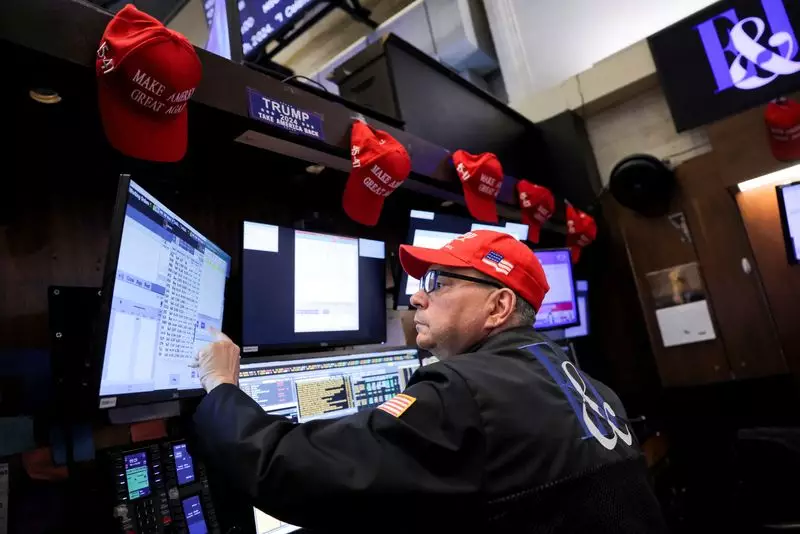As Donald Trump prepares to take office, his declaration to impose a 25% tariff on imports from Canada and Mexico, alongside an additional 10% on goods from China, has sent ripples throughout international markets. This bold strategy was met with a swift reaction: the U.S. dollar gained ground, surging 1% against the Canadian dollar and a notable 2% against the Mexican peso. Meanwhile, equity markets in Asia plummeted, and European futures were also negatively impacted — a clear testament to the jitters that such declarations can instigate among investors.
The initial shock of Trump’s tariff announcement highlights a potentially tumultuous period ahead for global trade relations. As stakeholders in the finance and trade sectors start to digest these changes, it becomes evident that the economic ramifications could be profound and long-lasting.
Economists and market strategists have been dissecting Trump’s trade intentions since his announcement. Gary Ng, a senior economist from Natixis in Hong Kong, characterized the market’s reaction as “definitely a shock.” The newly proposed tariffs are likely to squeeze profit margins within China’s export sectors, putting additional strain on corporations already navigating a challenging climate.
However, the impact of tariffs imposed on Canada and Mexico has sparked varied interpretations. Simon Yu of Panyao Asset Management hinted that this aggressive tariff approach may serve as a negotiation tactic, reflecting Trump’s penchant for leveraging trade barriers as bargaining chips in international relations. The dual-edge nature of such policies raises questions about sustainability and broader economic impacts.
Market strategists are further concerned that these tariffs could prompt retaliatory measures from affected countries. George Boubouras of K2 Asset Management pinpointed that these tariffs are still nascent policies, yet they signal a robust stance against the offshoring of American manufacturing jobs — a frequent grievance among U.S. trade officials.
The application of game theory is particularly relevant in contexts where tariffs are used as strategic tools of negotiation rather than as definitive policy measures. William Reinsch, a senior advisor at the Center for Strategic and International Studies, analogizes Trump’s tactics as akin to a repeated game of chicken — an assertiveness intended to compel surrender, which may not function effectively given the challenges faced in previous negotiations with countries like China.
Investment analysts, such as Jason Wong from BNZ, are apprehensive about reverting to the volatile market environments of previous years, when Trump’s policy declarations frequently shifted market sentiments. Wong posits that this atmosphere might become the new normal, presenting an unpredictable but constant variable for traders attempting to navigate the challenges of this evolving economic discourse.
The immediate reactions from currency markets indicate just how sensitive traders are to these developments. The peso and the Canadian dollar’s declines reflect this sensitivity, driven in part by anticipations over further U.S. trade actions. There’s an intriguing notion that while these initial shocks are significant, they may not persist in the long run. Khoon Goh from ANZ in Singapore mused about the potential conditional nature of Trump’s tariffs, relating them to broader concerns like immigration and drug trafficking, suggesting there may be greater strategic reasoning behind these moves than mere protectionism.
Market analysts also speculate on potential long-term outcomes of these announced measures. Tony Sycamore pointed out that Trump’s administration might be testing boundaries, gauging reactions while continuing to dominate the narrative. As such, the consistent reiteration of tariffs may serve a dual purpose: solidifying policy direction while simultaneously assessing market resilience.
As the landscape of trade relations shifts under Trump’s administration, the path forward will no doubt be intricate and multilayered. This announcement marks not just a policy change but a shift in how the U.S. perceives and engages with its trading partners. The interplay between tariffs, market confidence, and economic health will continue to unfold in the upcoming months.
The global economic community is left with both anxiety and anticipation. Will these tariffs drive down costs domestically by reshuffling supply chains and reinvigorating American manufacturing? Or will they escalate into a broader trade war, fueled by retaliatory tariffs and countermeasures? Only time will tell, but one thing remains clear: the ramifications of Trump’s policies will shape the future of global trade for years to come.

